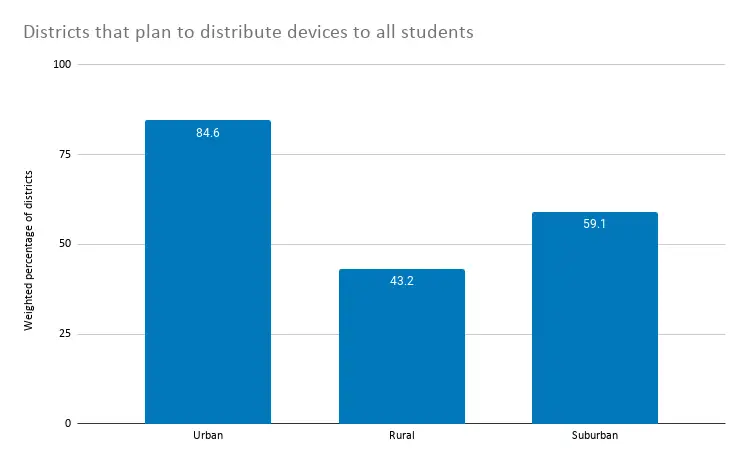Our research shows districts in rural areas have been significantly less likely to expect teachers to provide instruction during the COVID-19 pandemic. Schools with higher concentrations of students from low-income households have been less likely to expect teachers to provide real-time lessons, track students’ attendance, or grade their assignments.
One critical driver of these disparities between school systems is the digital divide: the inability of students to do schoolwork at home due to lack of internet or device access. We set out to make sense of data from different sources that shed light on the digital divide, the reasons for it, and the inadequacy of past efforts to close it. The COVID-19 crisis showed access to computers and the internet are now critical to children’s ability to access education, and underscores the urgent need for a national effort to close these gaps, once and for all.
A Pew Research Center poll conducted in early April 2020 revealed what is likely a more realistic nationally representative picture of homebound student experiences (Pew restricted their survey to families whose children are currently home due to a school closure): roughly one in five parents with homebound school-aged children say it is very likely or somewhat likely their children will not be able complete their schoolwork because they do not have access to a computer at home (21 percent) or must use public wifi to finish their schoolwork because there is not a reliable internet connection at home (22 percent). And about three in ten parents (29 percent) report that it is at least somewhat likely their children will have to do their schoolwork on a cell phone.
In a RAND Corporation survey of teachers: most teachers (75 percent) find “students’ lack of access to technological tools . . . and students’ lack of access to high-speed internet” is a serious obstacle to effective implementation of remote learning. In the same survey, however, many teachers (59 percent) report that all or most of their students have “access to a computer or tablet to use for school work when they need it.” Nearly a third (30 percent) report that just some of their students have access.
The US Census Household Pulse Survey shows a slightly less dire picture. As of June 2020, nearly 90 percent of adults in households with children in public and private school where classes were taught in a remote format say they always or usually have access to devices (86 percent) and internet (88 percent).
A Vast Income, Race, and Geographical Divide
While pinning down specific national numbers is difficult, what is painfully clear is that a disproportionate share of those who lack access to a reliable internet connection and devices are Black, Hispanic, live in rural areas, or come from low-income households.
According to the April Pew survey, nearly half of all parents with lower incomes say it is very likely or somewhat likely their children will have to do schoolwork on a cell phone (43 percent). Forty percent report the same likelihood of their child having to use public wifi to finish schoolwork because there is not a reliable internet connection at home, and around one third (36 percent) say it is at least somewhat likely their children will not be able to complete schoolwork because they do not have access to a computer at home.
Rural and urban parents whose children’s schools have closed are more likely than their suburban counterparts to think that it is at least somewhat likely their children will struggle with their schoolwork because of the lack of digital resources at home.
Education Trust surveyed parents in Washington State: 67 percent said that schools lending mobile technology devices like iPads would be very helpful for families like theirs. That number rises among parents who have children with disabilities (76 percent), families that earn less than $50,000 per year (73 percent), and single parents (72 percent).
In a recent Education Week Research Center survey, more than half (64 percent) of surveyed district leaders from high-poverty districts (more than 75 percent low-income student population) said technology access is a major challenge to learning during extended school shutdowns.
Nationally, less than one in three school districts include the distribution of mobile broadband hotspots as part of its COVID-19 response plan. Urban districts (48.5 percent) were nearly twice as likely to do so as rural and suburban districts (28.6 percent and 25.4 percent, respectively), according to our analysis of a statistically representative sample of 477 school districts.
The districts with the highest concentrations of students from low-income households were more likely (38.4 percent) to distribute hotspots than the districts with the most affluent student populations (20.5 percent).
That same analysis also found approximately half of districts said they planned to distribute computers, tablets, or similar devices to students. Again, we saw a significant divide between urban districts (84.6 percent) and their rural and suburban counterparts (43.2 percent and 59.1 percent, respectively).
The socioeconomic status divide was not nearly as stark as the geographic divide. Nearly 48 percent of districts with the highest concentrations of low-income families indicated they planned to distribute computers, compared to 52 percent of the districts with the fewest students who qualified for free or reduced-price lunch.
In other words, the communities where families face the greatest need for computers are not seeing greater efforts to ensure all students have them.
A Broken Delivery Model
This lack of equitable digital inclusion is the result of a years-long failure to prioritize the issue, which has “closed off ecosystem players and our nonprofits from reaching the most vulnerable students,” says Sherman Whites of the Kauffman Foundation. Whites also mentions that nonprofit providers are struggling to sustain themselves during this crisis, which only deepens the adverse conditions that the students they serve face.
As Dr. Marla Sheppard notes, there is a direct correlation between the economic gap and the digital inclusion gap, and this leads to lower engagement rates for students of lower socioeconomic statuses.
Despite many local initiatives to deliver wifi hotspots and devices during the pandemic, it is often difficult to reach homeless and other unique student populations. Students with parents who are working as first-line responders during the COVID-19 crisis, for example, may not be able to obtain devices at school district pickup locations.
The April Pew survey noted that concerns about the ability to pay internet or cell phone bills over the coming months may further exacerbate the divide. Some 28 percent of those who have a high-speed connection at home say they worry a lot or some about paying for this service over the next few months, and 30 percent of cell phone owners say they worry at least some about paying their cell phone bill. Hispanic or Black broadband or smartphone users and those with lower incomes are especially likely to say they worry about these types of bills.
Lack of Knowledge, Supports at Home
Even for students who have computers at home, technological malfunctions can force apps to crash and the internet to drop out. Furthermore, lack of access to software and equipment can hinder the learning process of students and parents who are not tech savvy.
According to Education Trust, 13 percent of Washington State parents, including parents located in urban areas (17 percent), say they do not know how to use the remote learning software that has been provided. Just 60 percent of surveyed parents give themselves a letter grade of A or B in terms of technological savvy.
Although most students today think of themselves as “digital natives,” many—especially younger students—still need support to get online and to work through technical challenges. Just half (51 percent) of teachers surveyed by RAND say that all or most of their students have “the age-appropriate skills to successfully navigate technology for distance learning.”
A Universal Right?
If access to free public education is a right in America, the COVID-19 crisis has revealed that in today’s world, basic connectivity—access to the internet, a device, and basic tech supports—are now the equivalent of paper and pencils. While most families can provide a digital “backpack” for their children, large swaths cannot. Closing the digital divide is necessary as a backup plan to crises. While it’s prudent to prepare for the next pandemic, regional natural disasters, such as hurricanes, extended snow days, and extended personal sicknesses, are all good reasons to equip every student with the ability to learn at home. Digital access also opens up new worlds of learning, access to advanced courses, and high-quality teaching that is not currently available to all students.
The good news is that there appears to be widespread support for closing the home connectivity gap. Surveys by the American Enterprise Institute show that a strong majority of parents (more than 70 percent) across all race, income, and political groups believe it is “important” or “extremely important” for schools to provide all students with access to the technology and devices they need to be able to learn from home.
As with the push for universal access to electricity, it will take a significant national investment to ensure that every student in America can learn from a distance. The moral obligation and return on investment, however, are arguably very high indeed.







